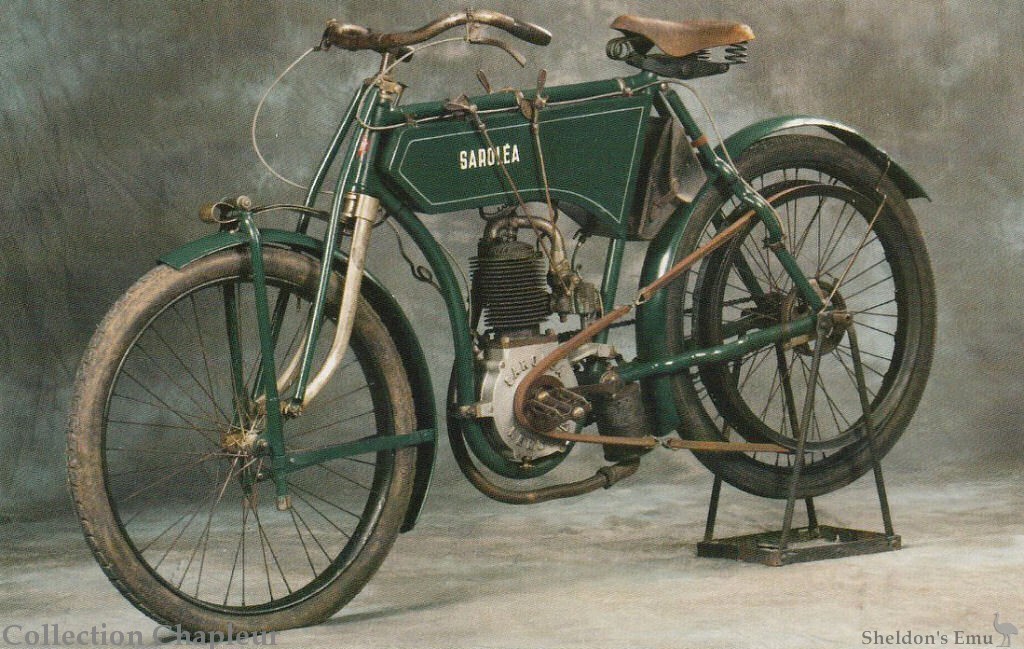


Sarolea was a Belgian manufacturer of bicycles, motorcycles and engines.
1850 The firm was established in 1850 at Herstal (Liege) as an arms factory by Joseph Sarolé.
In 1892 the production of bicycles commenced under the Royale Saroléa marque.
1892 Joseph died in 1894 and under the management of his widow and sons the company expanded considerably.
In the early years of the 20th century Saroleas were sold in Britain under the Kerry brand. Both singles and V-twins were made and the firm supplied engines to a number of manufacturers in several countries. In turn, Saroléa used a number of British components such as Sturmey-Archer gearboxes and AMAC carburettors. In the 1920s the firm was successfully involved with long distance runs, reliability trials and hill climbs fielding OHV machines which proved both succesful and popular.
1927 From 1927 on Sarolea made its own gearboxes and early in 1929 their factory was extended to some 6,000 m2. At this time nearly all components were made in-house and production capacity grew to 50 machines per day. Later in 1929 a brand new state-of-the-art production facility was commissioned which brought the production capacity to 75 machines per day.
Postwar, the firm survived until 1957 when it joined forces with FN and Gillet-Herstal. 1959 was the last year that the company had a full range of models, from the 97cc Benjamin to the 600cc Atlantic Major. They continued to market the Sarolea brand until 1963 when the company was acquired by Gillet, also of Herstal.
In 2010 the Saroléa name reappeared - it had been purchased by the Robbens brothers with the aim of producing electric racing motorcycles. For this purpose the twins, Torsten and Bjorn, built a new factory near Ghent. One of their close relatives had been a well-known Sarolea rider who competed in the 500cc European Motocross Championship for 4 years in the 1950s.
The Sarolea Motor-Bicycle
We gave a brief description of this machine a short time ago, and we are now able to give an illustration of the complete machine. The general appearance of the machine is pleasing, the frame being built with symmetrical outlines. The motor is placed almost vertically in a loop formed in the main tube. It is of 1¾ h.p., and drives by means of the usual twisted hide belt on the rear driving rim. Only two levers are employed for regulating, one for the compression tap and the other for the spark advance. There are one or two notable improvements adopted in the construction of the motor. Thus the fly wheels are connected with the piston rod in a special manner, and the axle and bearings are of greater length than usual. The pinion and cam are outside the crank chamber, and can thus be easily got at. A 2¼ h.p. motor is in course of construction, and will be put on the market shortly. The carburetter adopted, and which is found to give very uniform results, is the "Fabriques Nationales" Stenos type. Efficient brakes and mudguards are fitted to the machine.
Source: Motor Cycling Magazine, October 22nd. 1902.
Le Salon Belge, 1927
Saroléa, doyenne des marques belges. Quatre types 500 cmc. et 350 cmc., culbuteurs et soupapes latérales. Motos justement célébres ; grande diffusion dans le monde entier. Success en course inombrables.
Conserve la ligne générale qui lui est caractéristique. Seulement cadre surbaissé, freins de grands diam&tres, freins de direction Saroléa, amortisseurs efficaces suivant la tendance. Machine up to date, toujours en téte de la construction.
En conclusion, le Salon de Bruxelles montre que les constructeurs belges ont fourni un vigoureux effort général provoqué par le succ&s toujours croissant de la motocyclette en Belgique.
Saroléa, oldest of the Belgian brands. Four types 500cc and 350cc, overhead valve and side valve models. Rightly famous motorcycles; large worldwide distribution. Success in countless races.
Keeps the general line that it is feature. Only low frame, large diameter brakes, damped steering system, efficient shock absorbers following the trend. Machine up to date, always in the lead construction.
In conclusion, the Brussels Motor Show shows that Belgian manufacturers have made a vigorous general effort prompted by the ever increasing success of motorcycles in Belgium.
Le Salon Belge, Moto Revue December 24th 1927
Sources: Graces Guide, et al